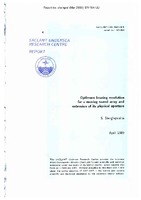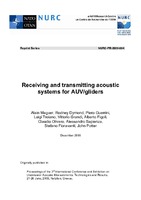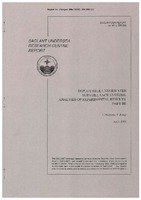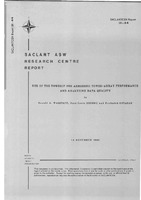Optimum bearing resolution for a moving towed array and extension of its physical aperture

Abstract
This report examines the limits of the angular resolution capability of a moving towed array (MTA) by finding the Cramer-Rao lower bound (CRLB), provides algorithms that extend the physical aperture of an MTA and compares the performance of these algorithms with the limits provided by the CRLBs. The model which is considered for the CRLB estimates assumes that an N hydrophone towed array is moving with known constant speed and that in the received signal unknowns are all the parameters (i.e. amplitude, frequency, bearing, initial phase) for two sources. The estimated CRLBs for this model indicated that an N-hydrophone MTA provides very high angular resolution when the duration T os the received signal is very long. This ability of the moving array to resolve two closely spaced sources is related to the fact that the physical aperture has been extended by the distance travelled by the array during the T seconds of the observation period. In the case of one source, the MTA has improved performance in comparison with a stationary array under the assumption that the transmitted frequency of the source is known. Computer simulation examples using a maximum likelihood estimator and an extended towed-array algorithm to find the bearings of sources are presented. The results of these simulations agree with the CRLB if the signal-to-noise ration is higher than 0 dB at the hydrophone level. Below this value the performance of both methods rapidly deteriorates. Applications of the extended towed-array algorithm on real data were successful, and the physical aperture of a 32-hydrophone MTA was extended to an equivalent of a 512-hydrophone fully populated stationary array.
Report Number
SR-154Date
1989/04Author(s)
Stergiopoulos, S.
Related items
Showing items related by title, author, creator and subject.
-
Receiving and transmitting acoustic systems for AUV/gliders
Maguer, Alain; Dymond, Rodney; Guerrini, Piero; Troiano, Luigi; Grandi, Vittorio; Figoli, Alberto; Olivero, Claudio; Sapienza, Alessandro; Fioravanti, Stefano; Potter, John Robert (NURC, 2009/12)NURC in the past years have focused its research on the use of AUV and more recently on gliders and is now developing littoral autonomous sensing networks based onthose sensors to perform missions such as mine warfare, ... -
Deployable underwater surveillance systems: analysis of experimental results: part III
Mozzone, Lorenzo; Bongi, Silvio (NATO. SACLANTCEN, 1999/04)Deployable Underwater Surveillance Systems (DUSS) are a new active sonar concept based on a distributed network of small multistatic transmitter / receiver nodes. This study analyzes data acquired during the period 29 June ... -
Use of the towship for assessing towed-array performance and analyzing data quality
Wagstaff, Ronald A.; Berrou, Jean-Louis; Cotaras, Frederick D. (NATO. SACLANTCEN, 1982/11)A series of relatively simple tests are presented and discussed, which used in conjunction with the noise received from the towship, can be used in real time to assess the performance of a towed array and the quality of ...


